Deborah Macgillivray's Blog, page 11
April 2, 2019
Sad news

Some of you have been following my husband's battle with Stage 4 Pancreatic Cancer on Facebook. I wish to thank the many people who answered questions about their experiences, and tried to help me on this dark journey. Something happened, maybe his heart gave out, but he passed quietly this past weekend. Right now I am going through various phases---shock, numbness, disbelief.
One of the last things he said to one of his doctors that how desperately he was just to sleep. It had been months since he slept a full night through. He sleeps now. No more pain.
This will take some time. He was a solid presence in my world for almost 50 years. That leaves a very big hole.
Published on April 02, 2019 16:49
March 31, 2019
Haint Blue and its intriguing meaning
The Haunting History of Haint Blue Ceilings

(my veranda with Haint Blue Ceiling)
Since early childhood, I have been fascinated by words and their meanings. We accept things, repeat them, generation after generation without ever stopping to wonder why we do it. One example of this is Haint Blue Ceilings.
If you have ever traveled through the South of the USA, and even into parts of the Northeast, you might come upon a curious phenomenon and its even stranger name. As you marveled at the beauty of these long verandas, which harken back to an era where once ladies sat all afternoon sipping their sweat tea or lemonade, you might wonder at the terrace’s color scheme. No matter what hue the house was painted—white, pink, yellow—if you looked up you might be surprised to see a green-blue ceiling on these graceful porches. They are called Haint Blue Porches. The original idea came from the word haint—a bastardization of the word haunt. It was often used in the context of a haint being a ghost or spirit that might try to haunt a home.

The Picts and Celts of Scotland considered the color blue sacred. Why Pict warriors would paint themselves with blue woad before going into battle. Blue held a power to these ancient people as they considered it the color of the sky—the home of the Auld Gods. The ceiling to the world, you might say. Long before it was popular to wear white, brides often wore pale shades of blue, because they were wrapping themselves in the protection of their deities. This also is a part of the wedding tradition we still say even today—something borrowed, something blue. If the bride didn't wear blue, she most certainly would have carried a blue kerchief, wore blue ribbons in her hair, or her garters would have been blue. When starting a new life, she would've wanted all the blessings she could gather.
A lot of the South was settled by immigrant Scots, second or third sons seeking to make their fortune, and with them came many of the traditions, lore and superstitions. Over the centuries, these customs and their meanings faded from memory. Brides now view white as the color of choice for weddings—but they still carry that bit of blue for good luck!

In that same mindset of bringing luck to your home, they painted their veranda ceilings a pale sky blue, essentially seeking protection for the entrance to their home with the blessings of blue. Ghosts were considered spirits doomed to wander the earth, and not allowed to move on to the peace of the heavens. Thus, when some restless spirit might try to enter a home, they wouldn't cross a porch protected by ancient deities. Such lore faded. Yet, those threads of blue bringing protection and good luck linger. Though the intent in painting the ceilings this shade passed away with long ago generations, people continued to paint their ceilings in this manner. If asked, the rare knowledgeable person might know some variation of the reasoning. Some mention blue is the color of water, and ghosts were thought to be unable to cross water. The blue stopped the spirit from crossing the porch to enter the home. I think that explanation is an example of how lore changes through the ages—and loses its true meaning. Similar purpose, though the logic behind has changed from sky to water. Why I still believe the sky was the origin of the blue ceilings—if they were imitating water to scare ghosts away why not paint the floors blue? The painting of the ceilings harkens back to old beliefs that transcends centuries and centuries of oral lore.
Even later, the explanation of the blue ceilings changed to a more current view—people sitting and rocking on the veranda on long summer days, could enjoy the shade and yet have a feeling of being out in nature. You only have to sit in a wooden rocker and gaze upon the blue ceiling to get that sense you are sitting “outside”


Behr Haint Blue Paint Hues
The haint became so attached to the blue ceilings that they were called Haint Blue Ceilings. So wide spread was the term, that paint companies actually manufacture the precise hues with the Haint Blue name to this day.
When I bought my current home after fire destroyed the former one, the seller stood on the veranda and spoke about the blue ceilings and how they were painted that way to make the older folk feel they were under a blue sky. I smiled. I think she was surprised when I called it a Haint Blue Ceiling. I was saddened when I moved in, to discover they had very nicely done some spring cleaning before we went to contract, and painted over my Haint Blue Ceiling and made it white. It was a hurried job of one coat, so the Haint Blue shimmers through the thin covering of white.

So, the next time you cross a porch, and glance up to see a blue ceiling, you can smile to yourself and know you are staring at a piece of history and the lore behind it—not an odd choice in paint pallets.
 Deborah Macgillivray
Deborah Macgillivray
Internationally Published Author of the Dragons of Challon series
and the Sisters of Colford Hall

(my veranda with Haint Blue Ceiling)
Since early childhood, I have been fascinated by words and their meanings. We accept things, repeat them, generation after generation without ever stopping to wonder why we do it. One example of this is Haint Blue Ceilings.
If you have ever traveled through the South of the USA, and even into parts of the Northeast, you might come upon a curious phenomenon and its even stranger name. As you marveled at the beauty of these long verandas, which harken back to an era where once ladies sat all afternoon sipping their sweat tea or lemonade, you might wonder at the terrace’s color scheme. No matter what hue the house was painted—white, pink, yellow—if you looked up you might be surprised to see a green-blue ceiling on these graceful porches. They are called Haint Blue Porches. The original idea came from the word haint—a bastardization of the word haunt. It was often used in the context of a haint being a ghost or spirit that might try to haunt a home.

The Picts and Celts of Scotland considered the color blue sacred. Why Pict warriors would paint themselves with blue woad before going into battle. Blue held a power to these ancient people as they considered it the color of the sky—the home of the Auld Gods. The ceiling to the world, you might say. Long before it was popular to wear white, brides often wore pale shades of blue, because they were wrapping themselves in the protection of their deities. This also is a part of the wedding tradition we still say even today—something borrowed, something blue. If the bride didn't wear blue, she most certainly would have carried a blue kerchief, wore blue ribbons in her hair, or her garters would have been blue. When starting a new life, she would've wanted all the blessings she could gather.
A lot of the South was settled by immigrant Scots, second or third sons seeking to make their fortune, and with them came many of the traditions, lore and superstitions. Over the centuries, these customs and their meanings faded from memory. Brides now view white as the color of choice for weddings—but they still carry that bit of blue for good luck!

In that same mindset of bringing luck to your home, they painted their veranda ceilings a pale sky blue, essentially seeking protection for the entrance to their home with the blessings of blue. Ghosts were considered spirits doomed to wander the earth, and not allowed to move on to the peace of the heavens. Thus, when some restless spirit might try to enter a home, they wouldn't cross a porch protected by ancient deities. Such lore faded. Yet, those threads of blue bringing protection and good luck linger. Though the intent in painting the ceilings this shade passed away with long ago generations, people continued to paint their ceilings in this manner. If asked, the rare knowledgeable person might know some variation of the reasoning. Some mention blue is the color of water, and ghosts were thought to be unable to cross water. The blue stopped the spirit from crossing the porch to enter the home. I think that explanation is an example of how lore changes through the ages—and loses its true meaning. Similar purpose, though the logic behind has changed from sky to water. Why I still believe the sky was the origin of the blue ceilings—if they were imitating water to scare ghosts away why not paint the floors blue? The painting of the ceilings harkens back to old beliefs that transcends centuries and centuries of oral lore.
Even later, the explanation of the blue ceilings changed to a more current view—people sitting and rocking on the veranda on long summer days, could enjoy the shade and yet have a feeling of being out in nature. You only have to sit in a wooden rocker and gaze upon the blue ceiling to get that sense you are sitting “outside”


Behr Haint Blue Paint Hues
The haint became so attached to the blue ceilings that they were called Haint Blue Ceilings. So wide spread was the term, that paint companies actually manufacture the precise hues with the Haint Blue name to this day.
When I bought my current home after fire destroyed the former one, the seller stood on the veranda and spoke about the blue ceilings and how they were painted that way to make the older folk feel they were under a blue sky. I smiled. I think she was surprised when I called it a Haint Blue Ceiling. I was saddened when I moved in, to discover they had very nicely done some spring cleaning before we went to contract, and painted over my Haint Blue Ceiling and made it white. It was a hurried job of one coat, so the Haint Blue shimmers through the thin covering of white.

So, the next time you cross a porch, and glance up to see a blue ceiling, you can smile to yourself and know you are staring at a piece of history and the lore behind it—not an odd choice in paint pallets.
 Deborah Macgillivray
Deborah MacgillivrayInternationally Published Author of the Dragons of Challon series
and the Sisters of Colford Hall
Published on March 31, 2019 16:00
March 27, 2019
Remembering Dawn on the anniversary of her Birthday

portrait done from Dawn's last photo
We were so close, it's hard to think we never actually met. Dawn Thompson breezed into my life, the belle of the ball - or so everyone thought. Despite losing her eleven years ago, she lingers, still very much alive in my thoughts.
And she gave me her sister Candy to watch over, to be my pal and constant companion. I am facing losing another person dear to me--my husband--and Candy is right there at my elbow, giving me strength and support.
There is so much of Dawn in her novels. I have discussed this with Candy--was she aware of how much of her was the fabric of her tales? We both agree Dawn was totally unaware of these elements. I recall our shared editor, Hilary Sares, saying she cried when she read the scene of the trees that were alive in Lord of the Deep. A tree that ached to be a part of life, but with limbs rooted to the ground. Or the angel in Lord of the Dark-- a poor thing couldn't sleep because his wings wouldn't retract. Again, only to someone who knew Dawn closely would that make sense. Dawn had the hardest time getting into bed every night, hard time sleeping because of the legs that no longer worked, the pain that dogged her every moment.
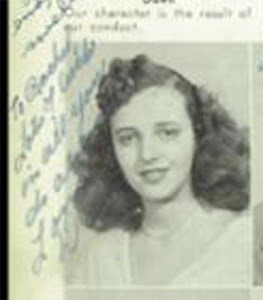
Dawn's high school portrait
Never have I known someone so valiant in the face of adversity, never have I heard someone laugh at all that life flung at her.
I miss you, Dawn Thompson, but you “gave” me your sister. Your last words to me was "Do not forget me." How could I ever forget such a bright light in this sad sorry world?
Happy Birthday, special lady.
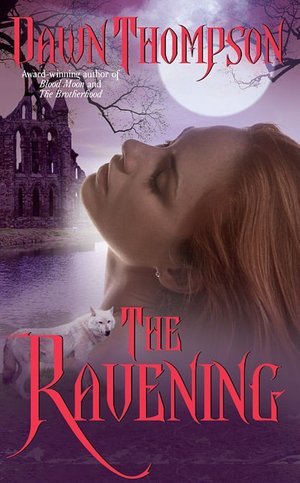
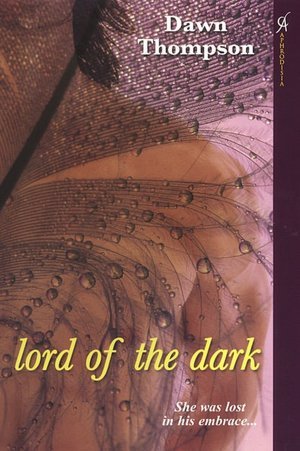

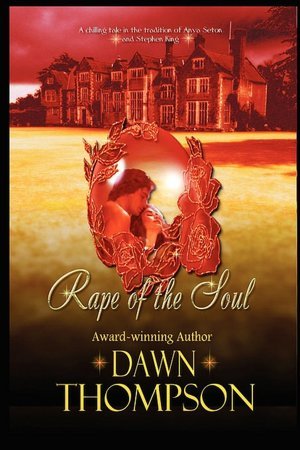
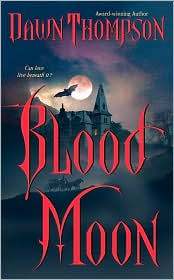
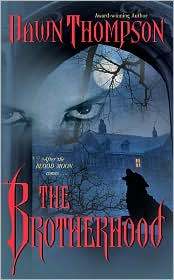
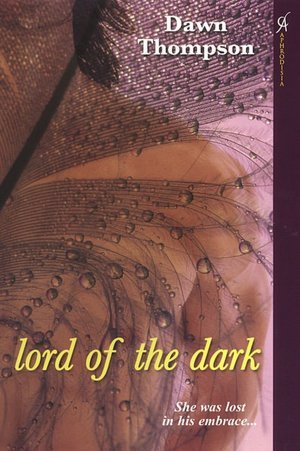



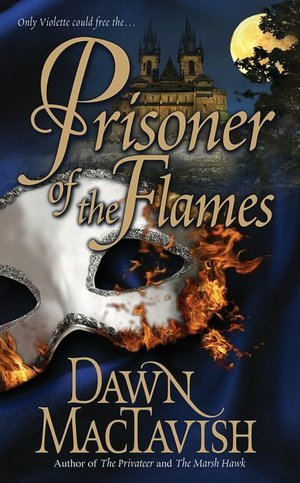

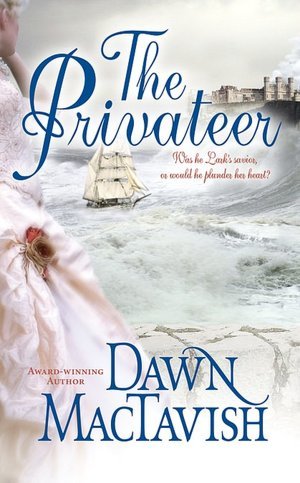
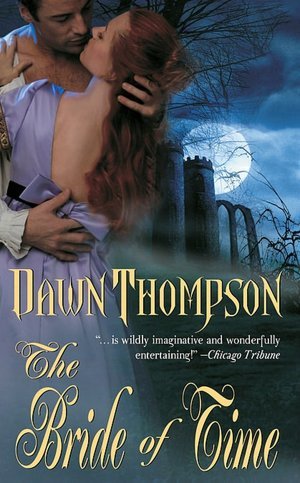
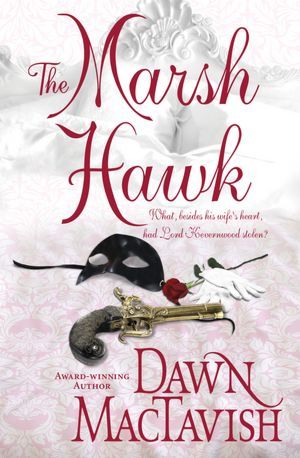
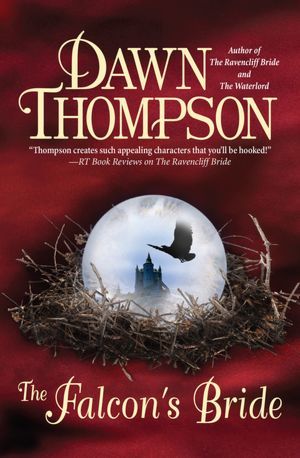


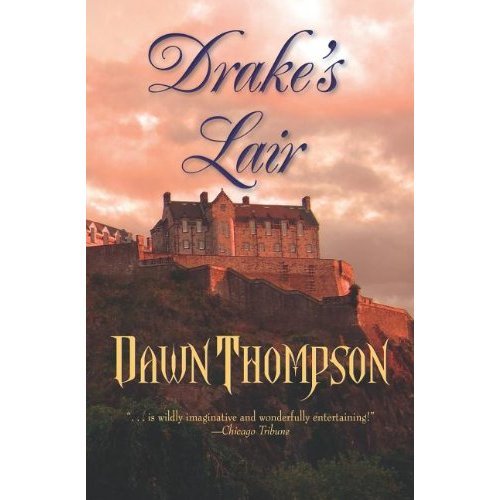

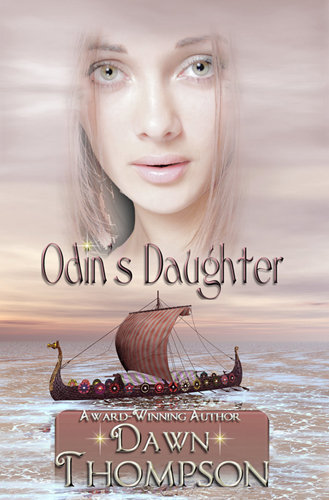
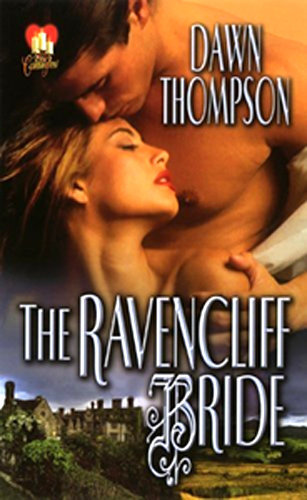

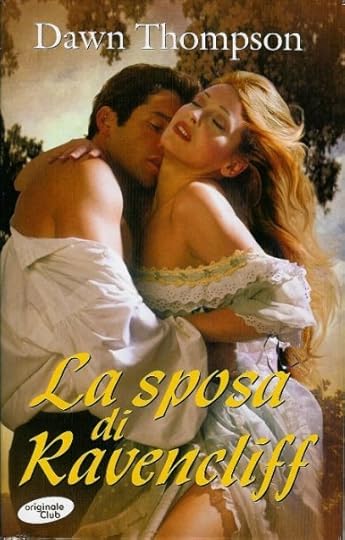

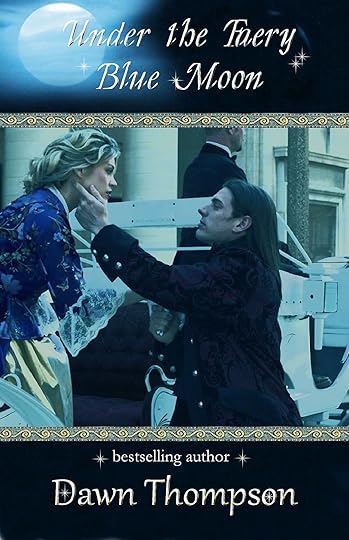
Coming Soon for her fans
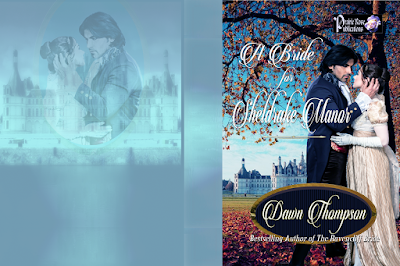
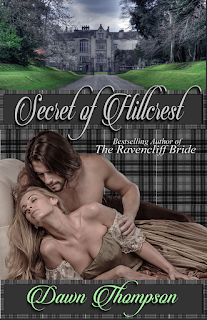
Published on March 27, 2019 17:38
March 20, 2019
Remembering Allie Lanois -- gone a year, but not forgotten
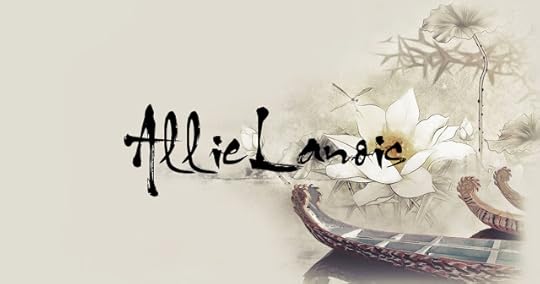
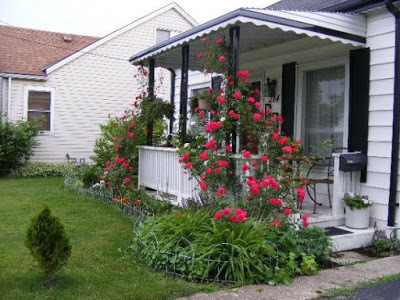


The loss of a dear friend. She was fiercely independent, but that independence was surpassed by her love of life and caring for her friends.
She is deeply missed
March 15, 2018
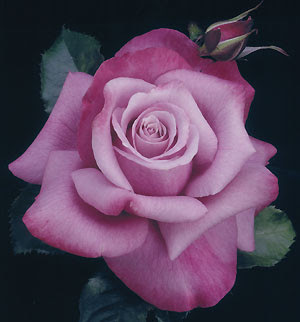

This was Allie's last Christmas present to me. TonightI was struck by how much it looks like her when she was very young

Published on March 20, 2019 11:13
March 10, 2019
Wonderful Review for A Restless Knight

Blurb:
Had the music stopped, or had she just ceased to hear it? All she could do was stare into the dragon green eyes. Drown in them. This man was her destiny. Nothing else mattered. He removed the netting from her grasp and then dropped it.
Shaking, Challon took her face in both hands. The hunger in his eyes rippled, tangible. So strong, it nearly robbed her of breath. With a need, tempered with reverence, he took her mouth with his. Lightly at first. Then deeper, more desperate, more demanding. The primitive male desire to mate unleashed. Beneath it all was his need for her—in ways she knew he did not begin to understand.
She smiled. He would.
Lost in the power, Tamlyn was not aware of the hundreds of other people around them or their celebrating. To her, the world stood still, narrowed, until there was nothing but the star-filled night.
And Challon.
“Deborah writes as if she’s been in Medieval Scotland and can somehow, magically, take you back there with her to stand amidst the heather and mist of another time. This is breathtakingly beautiful, award caliber writing.” — New York Times bestselling author, Lynsay Sands.
My review:
*closes the book and feels rudely jerked back to the 21st century.*
Whew!! What a trip!! After a few moments to let go of reality and immerse myself in the Scotland highlands of the late 1200s, I also became a captive of the Dragon of Challon and didn't want to escape my captor. haha!
I loved how Deborah Macgillivray painted the world around me with her words - it was almost like standing there and watching the words grow and bloom a new reality all around me -- I could sense the heather and apple blossoms, see the waves of flowing grass, hear the startling cry from the crows, feel the cool misty fog enveloping around me... then add in the emotions of the characters and I was enraptured! Toss in the smallest touch of mystic and a knight who's armor is not shining because he knows how to use it, and I'm enchanted.
Tamlyn charmed my heart with how strong and brave and defiant she was, but at the same time, she held a regal vulnerability, a softness, a gentleness to her. I loved being in her head as she encountered Julian and fell for her man. She truly was the perfect compliment to him, giving him the peace and calm and healing he so desperately needed.
Julian - the Black Dragon of Challon - his intensity, power, loyalty, determination, and protectiveness, along with his scary roughness, physical strength, and mental fortitude, overflowed from the pages into reality, gifting me with my favorite kind of hero - just with a sword and armor. Oh, and the way he shows his love and affection and devotion to Tamlyn? Watching it grow from an interesting challenge to intense love made me swoon over and over again. And feeling his arms wrap around me..... er.. Tamlyn? I'll take more of that, please. (so will she, I'm sure!)
This felt like the perfect never-ending story (said with much love and appreciation) - there was so much to Tamlyn and Julian's story that it could keep going on and on... and in fact, I still found myself wanting more. Hopefully in future books in this series we'll get to keep tabs on the couple. I also enjoyed how some famous historic characters were weaved into the story, making this feel as it was a true piece of history, and not simply a tale to while away a winter storm.
If you're a fan of epic and beautiful medieval tales, this is one that'll sweep you away!
Purchase links:
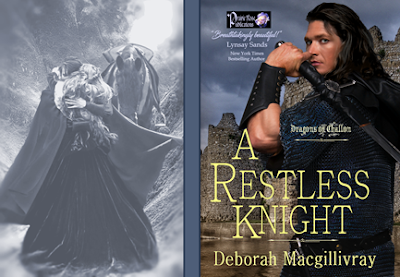
Published on March 10, 2019 16:13
March 2, 2019
Time for the best party a town ever throws -- Mardi Gras
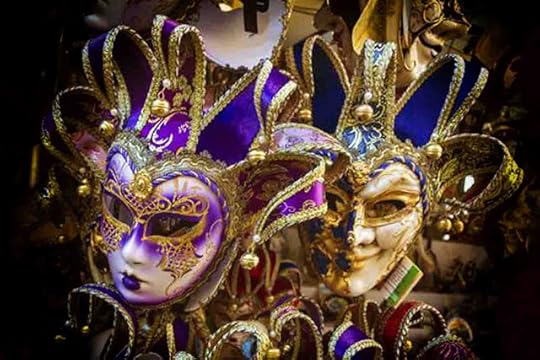
Mardi Gras
a celebration of excess New Orleans style
Tuesday March 5 this year

Mardi Gras is French for Fat Tuesday. It is the day before Ash Wednesday--when you give up luxuries for Lent. Facing weeks of doing without the things they enjoy, people went on merrymaking binges, knowing they would have to remain in their homes and fast afterward. Carnival is another word you see associated for the festive period. It comes from Medieval Latin, meaning remove the meat.

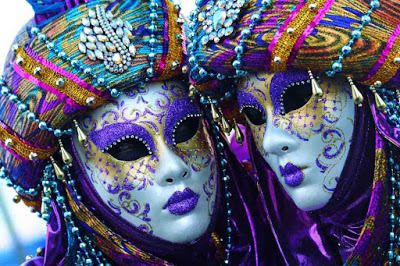
While several places around the world celebrate Carnival, New Orleans is likely the best known. The very first Mardi Gras celebration there took place in March 1699. French explorers, Pierre Le Moyne d’Iberville and Sieur de Bienville, landed near what is known today as New Orleans. Their party held a big celebration and christened the spot where they landed, calling it Pointe du Mardi Gras.
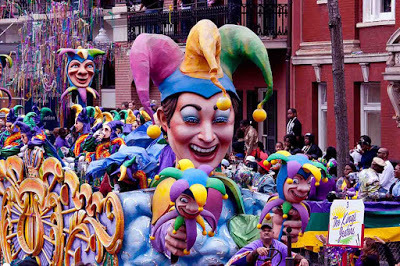
The King's Jester
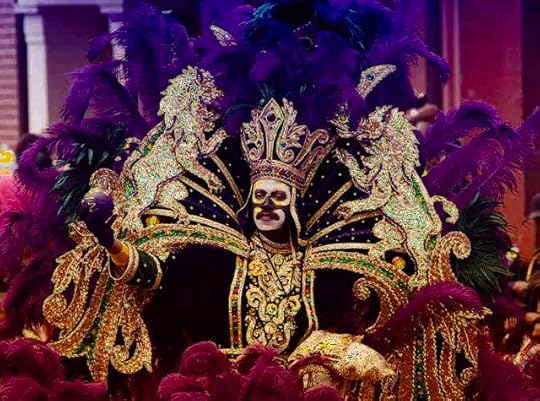
Krewe Zulu Parade
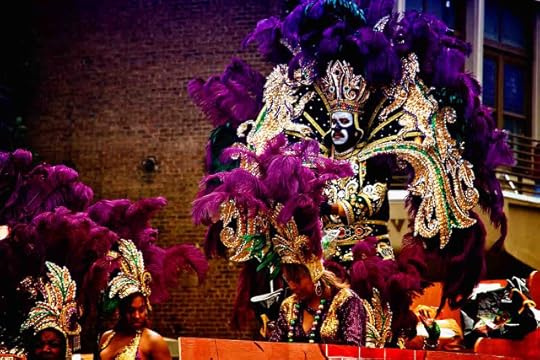
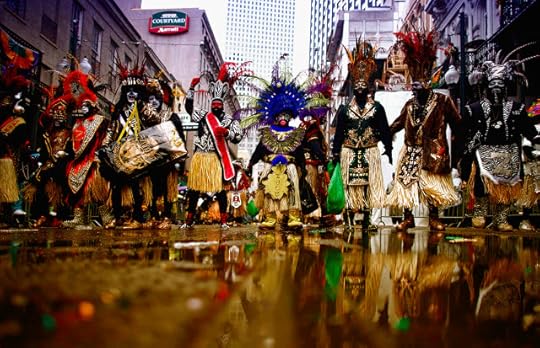
The French settlers that followed celebrated the day with street parties, masquerade balls and lavish feasts. However, when the Spanish took control of New Orleans, they were disgusted by the excesses, so they banned the celebrations and rituals. This dictate remained until 1812 when Louisiana became a state. In the late 1820s, groups of young men donned colorful costumes and paraded and danced through the streets. The celebrations began to expand each year, until the first official Mardi Gras celebration was recorded about ten years later.
The day is now a legal holiday in the state.
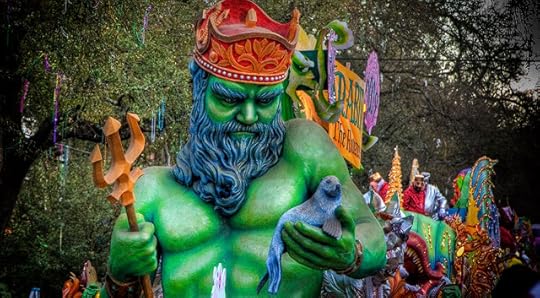
Krewe of Poseidon
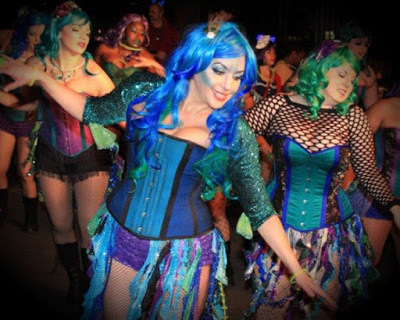
In the antebellum era of New Orleans the first Krewe was formed. A Krewe is a secret society that sponsors a parade and ball. The Mistick Krewe of Comus set the tone for all Mardi Gras celebrations thereafter. Now there are many Krewes: Poseidon, Rex, Orpheus, Bacchus, Endymion, Hermes, and Zulu are just a few-- so many their parades have to be on different days or times.
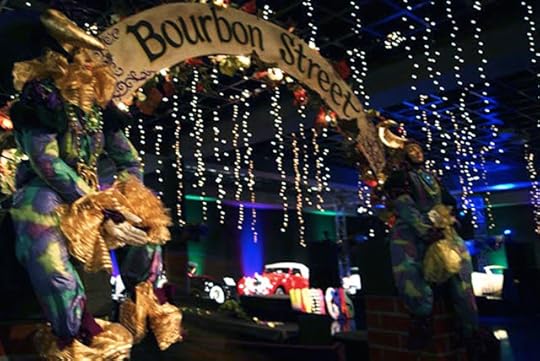
Bourbon Street
some parades are during the day, some at night
It's not advisable to wait to the last minute to go join the magnificent celebrations. Finding rooms near is impossible, so plan ahead, book ahead! Be sure to part take of a Poor Boy sandwich, Gumbo, Beignets, and especially don't miss having a big slice of King Cake.
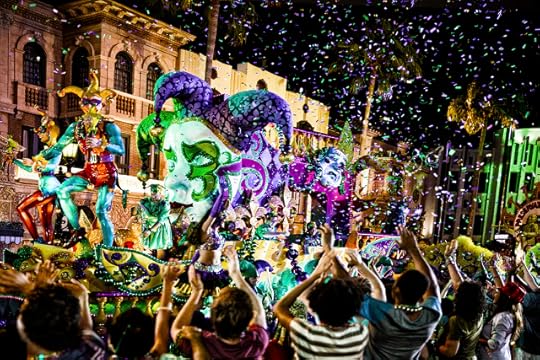


Flameauxs

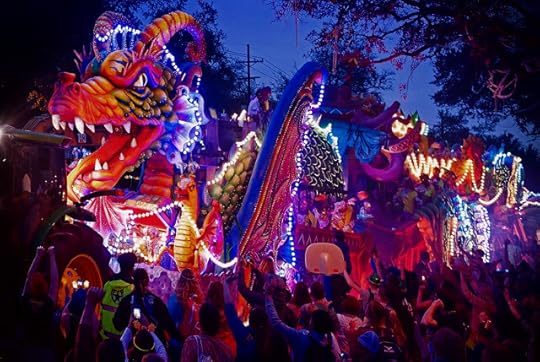
Krewe Leviathan

King Cake and King Cake Donuts

Laissez Le Bon Temps Rouler
Published on March 02, 2019 06:02
February 27, 2019
The History and Meaning Behind the Masks of Venice Carnival
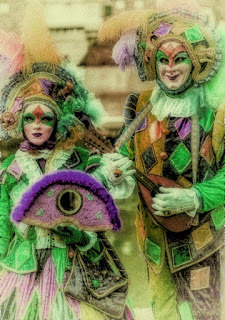
The History and Meaning Behind the Masks of Carnival
The Venice Carnival dates back to the 1300s, but has changed in purpose and style over the centuries, even banned by the Church at points. Not just a time of festivities, it saw a period of social change by the people, outside of government and Church. It was often used for political purposes, allowing the common man and nobility to move and navigate the troubled times without revealing their identities. In ancient years, the lengths of observances ran much longer, often months—sometimes nearly half of the year—as it permitted people to hold votes and work political machinations, giving voice, albeit anonymous to the common citizen, and allowing the nobles to work outside of their sphere to affect change. It often allowed romantic assignations, as the masked revelers moved from party to party, even indulged in the gaiety in the streets. Yet, it was so much more. Carnival was the budding of political and religious change that happened outside normal channels of government and Church.
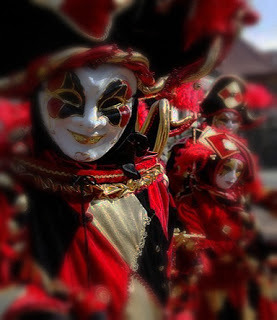
Currently, it runs the ten days before Ash Wednesday. On first glance, The Carnival of Venice shares many characteristics with the Mardi Gras celebrations in New Orleans. New Orleans is the Big Easy, with a party on down, Cher that sees less emphasis on the traditional costumes, and focuses on enjoying the best time ever. The Venice celebration still draws heavily on their Medieval roots and customs of their elaborate costumes. The fancy attire slowly evolved over the centuries, yet remained firmly rooted in the Medieval origins. Venetians generally started holding their masked parties on the 26th of December—the start of Lent. Masks were created to conceal identities, thus reflecting a social change, allowing the lowest classes and nobility to mingle. Peasants and aristos alike could indulge in grand balls, dancing and partying throughout the long winter nights. The anonymity of masks permitted a freedom to let their inner wishes and fantasies take life. Gambling, drinking and indulging in clandestine affairs happened with no repercussions, which soon proved advantageous for furtive political aspirations. Soon, it was obligatory to wear masks at certain governmental decision-making events, where all citizens were required to act anonymously as peers. Through the masquerades the divisions of aristo and serf lines blurred. The protected processes, in truth, were the first steps to a democracy. To see this balloting was fair and secure, men were not permitted to carry swords or guns while wearing masks, and the police enforced this law religiously. Thus, you see the masks and their meanings carry a more involved significance that just hiding who you were and having a good time.
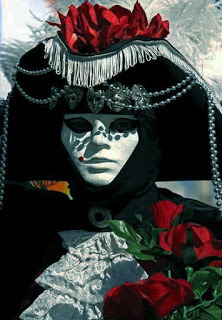
The original mask was named the Batua. It was always white, and made of ceramic or leather. The name comes from behüten, meaning to protect. The mask fit over the whole face, completely concealing the wearer’s identity. To further hide who they were, a hood of black or red covered their heads and reached their shoulders, and was topped by a black tricono—a tri-corner hat. A long black or red cape finished the costume. While designed for a man, women soon were taking advantage of the opportunity the outfit afforded them. The mouth on the mask was very small and expressionless, with oval slits for eyes, and two air holes on the nose. While the mask afforded complete protection, it did not allow the wearer to eat or drink without taking it off.
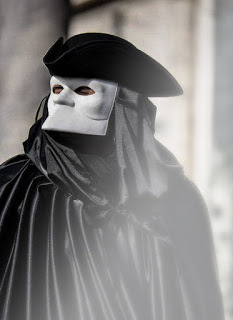
The Volta was the next style to rise. It completely cover the face, but often held a ghostly or more sinister expression. Also called the Larva Mask—Larva meaning ghost—it was a slightly unnerving countenance, though it did let the wearer eat and drink easily.
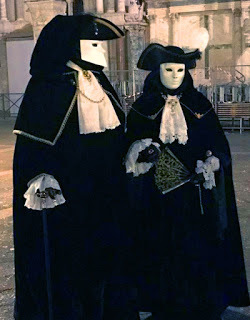
Usually worn by men, again they came with black hoods covering hair and shoulders, black capes and the black tricorno hat.
Women quickly saw disadvantage to the full covering, and adopted the Moretta. Originating in France, the Moretta, allowed their feminine features to be showcased with less coverage. The design quickly saw this mask losing favor. Also called the Silent Mask, women held the mask before their face by clenching a tabbed button between their teeth. I can imagine they quickly wanted changes to this style! Surely, a man invented this one.
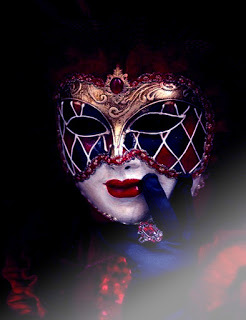
Disenchanted with the Moretta’s enforced silence, women soon flocked to the Columbina masks. Inspired by Commedia dell’arte. The art form was improvised plays, very popular from the 1500s. Each held a set stock of comedic characters for the actors, a few basic plots—such as troubled love affairs—but often they reflected current events and political protests in the guise of comedy. Much like political cartoons of today, these street plays poked fun at politicians and the Church, all in the perimeters of comedy and entertainment. The female standard in the plays had a demi-masque, only covering part of the forehead, eyes and upper parts of the nose and cheeks, revealing, yet more flattering to the female face. These were decorated with gold, silver, crystals, and colorful plumes, especially peacock feathers, and tied with ribbons to hold them in place or carried on a baton. Today, the costuming has been taken to a high art form.
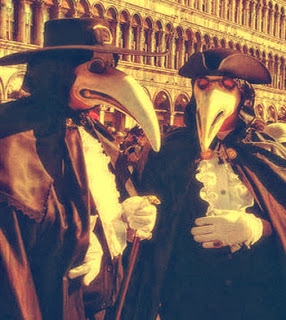
One of the more bizarre ones you will see is the Medico Della Peste (Plague Doctor). These startling bird-beak style masks were created in the 1600s by a French physician Charles de Lorme, and not for the purposes of Carnival celebrating. Just the opposite, de Lorme formed them to protect doctors treating plague victims. By this time, foul airs were suspect as the cause of spreading the plague, and in response, naturally physicians wanted to guard themselves against infection. De Lorme decided plague tainted the air with these noxious fumes, so then if the physicians breathed perfumed air they would escape catching the disease. He created this grotesque mask that looked like a larger-than-life bird head. The exaggerated beak was filled with herbs, and the eye slits were covered with rose tinted lenses. Literally, several pieces of common knowledge have passed into our consciousness from this horrible period. The term looking through rose colored glasses, now meaning viewing the world in a beautiful tone, instead of facing reality, came from the creation of these physicians’ masks. The other was the old tome Ring Around the Rosie—a child’s rhyme that speaks about the mass spreading of deaths from the Black Death. Children of future generations repeated this morbid singsong without ever understanding what they were chanting. To further the protection of the healers, physicians wore hoods covering their head and shoulders, long gowns and capes, with huge white gloves that went all the way up their upper arms. The Japanese used the figure of Godzilla, first to explain the bombs that were dropped on them during WWII, and then through making Godzilla the protector of their island, they faced their terrors and made the nightmare less disturbing. The Venetians did the same in adopting this bizarre costume as part of the collection of characters. They were saying that death walked amongst them, and they mocked and laughed at mortality.
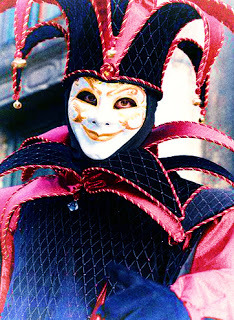
Arlecchino was a later addition. Coming from the French Arleguin—this evolved to the more familiar Harlequin. He was a fool, depicted dressed in diamonds of black and white, or a rainbow of colors. Another version on this theme was the Pulcinella—a crook-nosed hunchback, that you typically saw as Punch in the Punch and Judy street puppet theatre performers.

The final two you will see are La Ruffina—the Old Woman. She is usually the mother or, grandmother, sometimes with Gypsy portrayals, who takes great delight in trying to foil a lovers' tryst. Scaramuccia, again comes from the French Scaramouche. He was a total rogue, who dashed about with a sword causing mischief, and challenging other males to mock duels. Rounding out the costumes were ones of the Moon and Sun, religious popes and bishops, kings and queens, or sometimes animals such as cats and wolves.

By the 1800s, Carnival began to fall into decline. It had changed from the period of Lent, to lasting for six months of every year. In 1797 Venice became a part of the Kingdom of Lombardy-Venetia, after Napoleon signed the Treaty of Campo Formio. The Austrians quickly took charge of the city, and afterward the celebrations all but stopped. It was a long absence before Venice saw a true Carnival again. In 1979, the government decided to revive the traditions of the celebration, using it to draw tourists. The move worked as over three million visitors come to Venice each year for the colorful pre-Lent parades and parties. A centerpiece for the ten day festival is the la maschera più bella—the most beautiful mask. A panel of international designers pick the most stunning mask for each year.
So, even if you have experienced the unforgettable Mardi Gras of New Orleans, you might still wish to indulge in the extravagance, pageantry and historical display of Carnival in Venice.
© Deborah Macgillivray, February 2019
Published on February 27, 2019 11:12
February 7, 2019
A Wonderful review of A Restless Knight
Sunshine Lake ReviewsHomeThursday, February 7, 2019
 *closes the book and feels rudely jerked back to the 21st century.*Whew!! What a trip!! After a few moments to let go of reality and immerse myself in the Scotland highlands of the late 1200s, I also became a captive of the Dragon of Challon and didn't want to escape my captor. haha!
*closes the book and feels rudely jerked back to the 21st century.*Whew!! What a trip!! After a few moments to let go of reality and immerse myself in the Scotland highlands of the late 1200s, I also became a captive of the Dragon of Challon and didn't want to escape my captor. haha!I loved how Deborah Macgillivray painted the world around me with her words - it was almost like standing there and watching the words grow and bloom a new reality all around me -- I could sense the heather and apple blossoms, see the waves of flowing grass, hear the startling cry from the crows, feel the cool misty fog enveloping around me... then add in the emotions of the characters and I was enraptured! Toss in the smallest touch of mystic and a knight who's armor is not shining because he knows how to use it, and I'm enchanted.
Tamlyn charmed my heart with how strong and brave and defiant she was, but at the same time, she held a regal vulnerability, a softness, a gentleness to her. I loved being in her head as she encountered Julian and fell for her man. She truly was the perfect compliment to him, giving him the peace and calm and healing he so desperately needed.
Julian - the Black Dragon of Challon - his intensity, power, loyalty, determination, and protectiveness, along with his scary roughness, physical strength, and mental fortitude, overflowed from the pages into reality, gifting me with my favorite kind of hero - just with a sword and armor. Oh, and the way he shows his love and affection and devotion to Tamlyn? Watching it grow from an interesting challenge to intense love made me swoon over and over again. And feeling his arms wrap around me..... er.. Tamlyn? I'll take more of that, please. (so will she, I'm sure!)
This felt like the perfect never-ending story (said with much love and appreciation) - there was so much to Tamlyn and Julian's story that it could keep going on and on... and in fact, I still found myself wanting more. Hopefully in future books in this series we'll get to keep tabs on the couple. I also enjoyed how some famous historic characters were weaved into the story, making this feel as it was a true piece of history, and not simply a tale to while away a winter storm.
If you're a fan of epic and beautiful medieval tales, this is one that'll sweep you away!
https://sunshinelakereviews.blogspot....
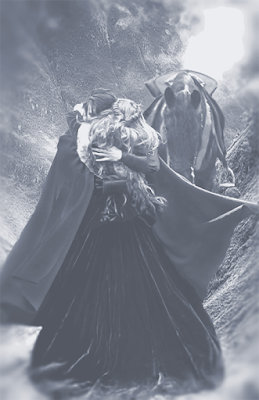
Published on February 07, 2019 16:19
January 26, 2019
Up Helly Aa - A New Age Viking-Scottish Tradition
Up Helly Aa
A New Age Viking-Scottish Tradition
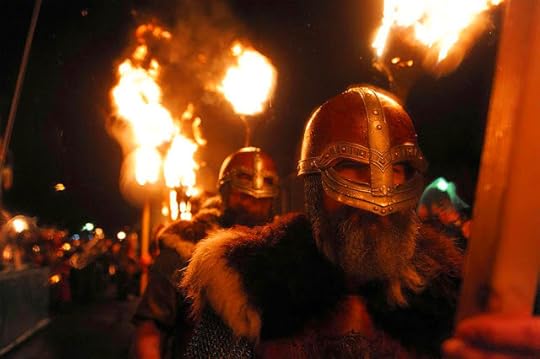
Up Helly Aa takes place in Lerwick, Shetland on the last Tuesday in January every year, with only breaks for the death of Queen Victoria (1901) the First and Second World Wars, and postponements for two weeks in 1900 for influenza outbreak and for the death of George V, and one week for the death of Winston Churchill. Though the festival has a very ancient Norse feeling, Up Helly Aa is a tradition that only originated in the 1880s. Since that time, the fire festival has been an annual event in the Shetlands. The current festival held in Lerwick grew out of the older Yuletide tradition of Tar Barreling, which took place at Christmastime and New Year.
Though the festival has a very ancient Norse feeling, Up Helly Aa is a tradition that only originated in the 1880s. Since that time, the fire festival has been an annual event in the Shetlands. The current festival held in Lerwick grew out of the older Yuletide tradition of Tar Barreling, which took place at Christmastime and New Year.

Rowdy lads would drag barrels of burning tar through town on sledges and making mischief. As this grew out-of-hand, the rites were abolished around the mid-1870s. After a few years, people began to miss the festivity so they obtained permission to have a torch procession, the first one taking place in 1876.
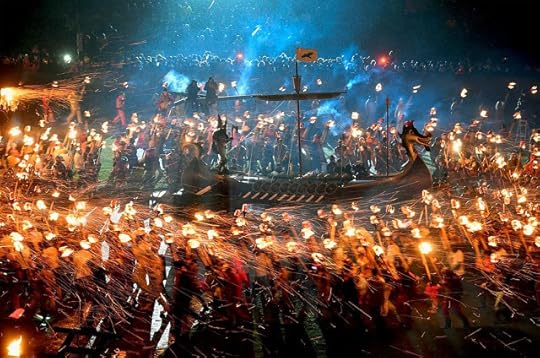
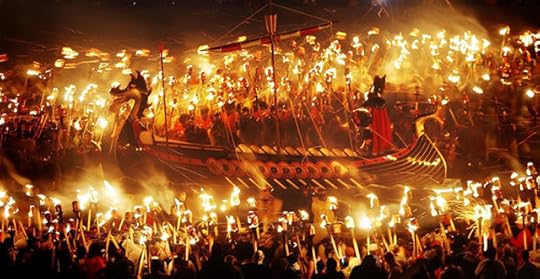
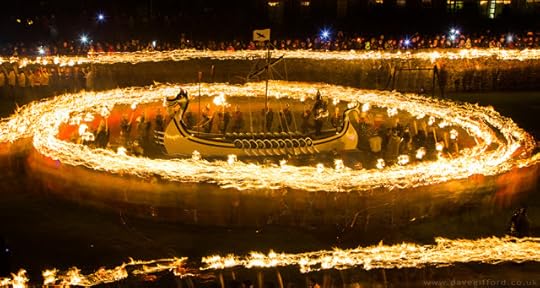
Soon, that was expanded into Up Helly Aa Day in 1881. The first Viking galley was burned in 1889 at the end of the parade at the Market Cross. Early Galleys were made from a light timber frame of discarded wood, and covered with canvas. Modern Galleys are built and painted by local tradesmen. Work starts at the end of October and continues two nights a week until completed.

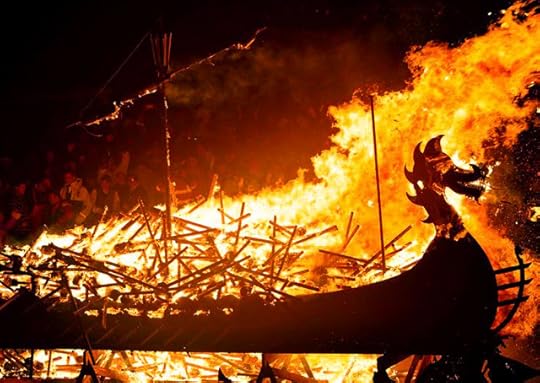
The torches in the parade are constructed from hessian sacks, with concrete “shoulders” to ensure they stay in place during the procession. The Monday before Up Helly Aa, all the torches are soaked in fuel to ensure they burn well and last long.
Each year sees it grow in popularity.
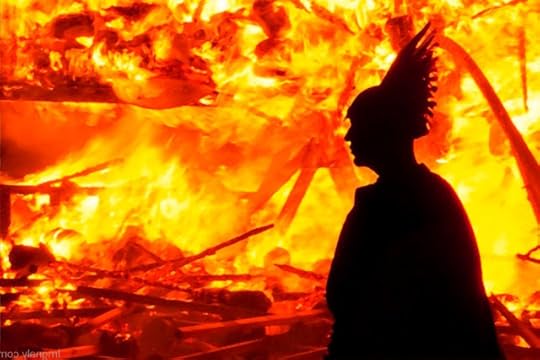
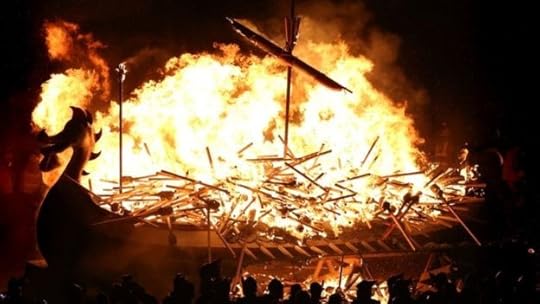
A New Age Viking-Scottish Tradition

Up Helly Aa takes place in Lerwick, Shetland on the last Tuesday in January every year, with only breaks for the death of Queen Victoria (1901) the First and Second World Wars, and postponements for two weeks in 1900 for influenza outbreak and for the death of George V, and one week for the death of Winston Churchill.
 Though the festival has a very ancient Norse feeling, Up Helly Aa is a tradition that only originated in the 1880s. Since that time, the fire festival has been an annual event in the Shetlands. The current festival held in Lerwick grew out of the older Yuletide tradition of Tar Barreling, which took place at Christmastime and New Year.
Though the festival has a very ancient Norse feeling, Up Helly Aa is a tradition that only originated in the 1880s. Since that time, the fire festival has been an annual event in the Shetlands. The current festival held in Lerwick grew out of the older Yuletide tradition of Tar Barreling, which took place at Christmastime and New Year. 
Rowdy lads would drag barrels of burning tar through town on sledges and making mischief. As this grew out-of-hand, the rites were abolished around the mid-1870s. After a few years, people began to miss the festivity so they obtained permission to have a torch procession, the first one taking place in 1876.



Soon, that was expanded into Up Helly Aa Day in 1881. The first Viking galley was burned in 1889 at the end of the parade at the Market Cross. Early Galleys were made from a light timber frame of discarded wood, and covered with canvas. Modern Galleys are built and painted by local tradesmen. Work starts at the end of October and continues two nights a week until completed.


The torches in the parade are constructed from hessian sacks, with concrete “shoulders” to ensure they stay in place during the procession. The Monday before Up Helly Aa, all the torches are soaked in fuel to ensure they burn well and last long.
Each year sees it grow in popularity.


Published on January 26, 2019 16:56
Up Helly AaA New Age Viking-Scottish TraditionUp Helly Aa...
Up Helly Aa
A New Age Viking-Scottish Tradition

Up Helly Aa takes place in Lerwick, Shetland on the last Tuesday in January every year, with only breaks for the death of Queen Victoria (1901) the First and Second World Wars, and postponements for two weeks in 1900 for influenza outbreak and for the death of George V, and one week for the death of Winston Churchill. Though the festival has a very ancient Norse feeling, Up Helly Aa is a tradition that only originated in the 1880s. Since that time, the fire festival has been an annual event in the Shetlands. The current festival held in Lerwick grew out of the older Yuletide tradition of Tar Barreling, which took place at Christmastime and New Year.
Though the festival has a very ancient Norse feeling, Up Helly Aa is a tradition that only originated in the 1880s. Since that time, the fire festival has been an annual event in the Shetlands. The current festival held in Lerwick grew out of the older Yuletide tradition of Tar Barreling, which took place at Christmastime and New Year.

Rowdy lads would drag barrels of burning tar through town on sledges and making mischief. As this grew out-of-hand, the rites were abolished around the mid-1870s. After a few years, people began to miss the festivity so they obtained permission to have a torch procession, the first one taking place in 1876.



Soon, that was expanded into Up Helly Aa Day in 1881. The first Viking galley was burned in 1889 at the end of the parade at the Market Cross. Early Galleys were made from a light timber frame of discarded wood, and covered with canvas. Modern Galleys are built and painted by local tradesmen. Work starts at the end of October and continues two nights a week until completed.


The torches in the parade are constructed from hessian sacks, with concrete “shoulders” to ensure they stay in place during the procession. The Monday before Up Helly Aa, all the torches are soaked in fuel to ensure they burn well and last long.
Each year sees it grow in popularity.


A New Age Viking-Scottish Tradition

Up Helly Aa takes place in Lerwick, Shetland on the last Tuesday in January every year, with only breaks for the death of Queen Victoria (1901) the First and Second World Wars, and postponements for two weeks in 1900 for influenza outbreak and for the death of George V, and one week for the death of Winston Churchill.
 Though the festival has a very ancient Norse feeling, Up Helly Aa is a tradition that only originated in the 1880s. Since that time, the fire festival has been an annual event in the Shetlands. The current festival held in Lerwick grew out of the older Yuletide tradition of Tar Barreling, which took place at Christmastime and New Year.
Though the festival has a very ancient Norse feeling, Up Helly Aa is a tradition that only originated in the 1880s. Since that time, the fire festival has been an annual event in the Shetlands. The current festival held in Lerwick grew out of the older Yuletide tradition of Tar Barreling, which took place at Christmastime and New Year. 
Rowdy lads would drag barrels of burning tar through town on sledges and making mischief. As this grew out-of-hand, the rites were abolished around the mid-1870s. After a few years, people began to miss the festivity so they obtained permission to have a torch procession, the first one taking place in 1876.



Soon, that was expanded into Up Helly Aa Day in 1881. The first Viking galley was burned in 1889 at the end of the parade at the Market Cross. Early Galleys were made from a light timber frame of discarded wood, and covered with canvas. Modern Galleys are built and painted by local tradesmen. Work starts at the end of October and continues two nights a week until completed.


The torches in the parade are constructed from hessian sacks, with concrete “shoulders” to ensure they stay in place during the procession. The Monday before Up Helly Aa, all the torches are soaked in fuel to ensure they burn well and last long.
Each year sees it grow in popularity.


Published on January 26, 2019 16:56



